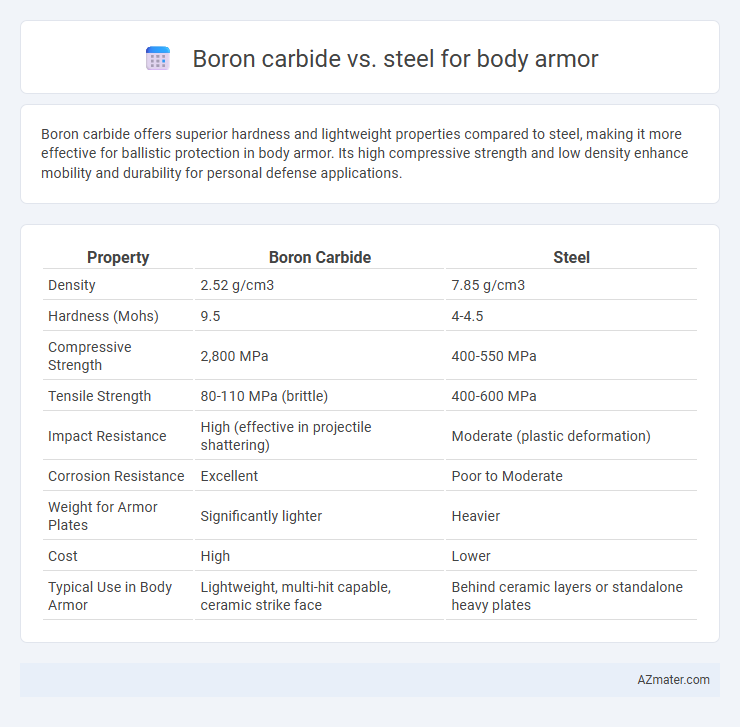Boron carbide offers superior hardness and lightweight properties compared to steel, making it more effective for ballistic protection in body armor. Its high compressive strength and low density enhance mobility and durability for personal defense applications.
Table of Comparison
| Property | Boron Carbide | Steel |
|---|---|---|
| Density | 2.52 g/cm3 | 7.85 g/cm3 |
| Hardness (Mohs) | 9.5 | 4-4.5 |
| Compressive Strength | 2,800 MPa | 400-550 MPa |
| Tensile Strength | 80-110 MPa (brittle) | 400-600 MPa |
| Impact Resistance | High (effective in projectile shattering) | Moderate (plastic deformation) |
| Corrosion Resistance | Excellent | Poor to Moderate |
| Weight for Armor Plates | Significantly lighter | Heavier |
| Cost | High | Lower |
| Typical Use in Body Armor | Lightweight, multi-hit capable, ceramic strike face | Behind ceramic layers or standalone heavy plates |
Introduction to Body Armor Materials
Boron carbide and steel are two prominent materials used in body armor due to their distinct properties. Boron carbide is a ceramic known for its exceptional hardness and lightweight, offering superior ballistic protection against high-velocity projectiles. Steel armor provides high tensile strength and durability but is considerably heavier, affecting mobility and comfort in protective gear applications.
Overview of Boron Carbide
Boron carbide is an exceptionally hard ceramic material widely used in body armor due to its high hardness-to-weight ratio and excellent ballistic resistance. It offers superior protection against armor-piercing rounds compared to traditional steel plates while significantly reducing the overall weight worn by the user. Its chemical stability and resistance to wear make it an ideal choice for lightweight, durable armor systems in military and law enforcement applications.
Overview of Steel Armor
Steel armor offers excellent strength and durability due to its high tensile strength and impact resistance, making it a popular choice for body armor in military and law enforcement applications. Its weight tends to be heavier compared to boron carbide, which affects mobility and comfort during extended wear. Steel armor also provides superior multi-hit capability but can be prone to spalling, which requires additional coatings or backing materials to enhance wearer safety.
Weight Comparison: Boron Carbide vs Steel
Boron carbide is significantly lighter than steel, making it an ideal material for body armor where weight reduction is crucial for mobility and comfort. While steel plates typically weigh around 8 kg/m2, boron carbide armor can weigh approximately 3.5 kg/m2, offering nearly 50% weight savings. This substantial weight difference enhances wearer endurance and maneuverability without compromising ballistic protection.
Protection Levels and Ballistic Performance
Boron carbide offers superior hardness and lightweight characteristics compared to steel, making it highly effective for multi-hit ballistic protection in body armor. Its high compressive strength allows it to absorb and disperse the energy of high-velocity projectiles more efficiently, enhancing protection levels against armor-piercing rounds. While steel armor provides robust resistance and lower cost, its greater weight and susceptibility to spalling reduce overall ballistic performance in comparison to boron carbide composites.
Durability and Longevity
Boron carbide exhibits superior hardness, ranking just below diamond, which provides exceptional resistance to penetration and wear compared to steel, making it ideal for high-performance body armor. Its low density also contributes to lighter armor that maintains durability without compromising maneuverability. Steel armor, while tougher in terms of impact resistance and more resistant to cracking, tends to be heavier and prone to corrosion, which can reduce longevity unless properly maintained.
Comfort and Wearability
Boron carbide offers superior hardness and lightweight properties compared to steel, making body armor constructed from it significantly more comfortable for extended wear due to reduced weight and bulk. Its ceramic composition provides better heat resistance and prevents overheating, enhancing wearability in various climates. Steel, while more affordable and durable against multiple impacts, tends to be heavier and less breathable, often causing discomfort and fatigue during prolonged use.
Cost Analysis: Boron Carbide vs Steel
Boron carbide body armor offers superior hardness and lightweight protection but comes at a significantly higher cost compared to steel armor, often priced three to five times more per square foot. Steel armor is more cost-effective, providing durable protection at a fraction of the price, making it a preferred choice for budget-conscious applications despite its added weight and potential for spall. Factoring in long-term durability and manufacturing complexities, boron carbide's expense is justified in high-performance settings, whereas steel remains dominant in cost-sensitive markets.
Applications in Military and Law Enforcement
Boron carbide offers superior hardness and lightweight properties compared to steel, making it ideal for advanced military and law enforcement body armor where mobility and protection are critical. Its high hardness enables effective resistance against high-velocity projectiles and armor-piercing rounds, outperforming traditional steel plates in ballistic performance. Steel, while heavier and less effective against modern threats, remains in use for its durability and cost efficiency, often in conjunction with ceramic materials to balance protection and weight.
Choosing the Right Material for Your Needs
Boron carbide offers superior hardness and lightweight protection, making it ideal for high-performance body armor designed to stop rifle rounds while minimizing wearer fatigue. Steel plates, although heavier and prone to spalling, provide cost-effective durability and multi-hit capacity suitable for budget-conscious applications or training scenarios. Selecting the right material depends on balancing protection level, weight constraints, budget, and operational requirements to ensure optimal personal safety.

Infographic: Boron carbide vs Steel for Body armor
 azmater.com
azmater.com